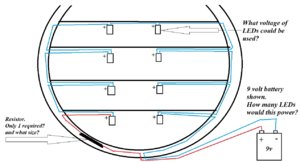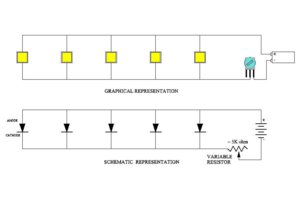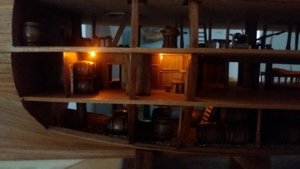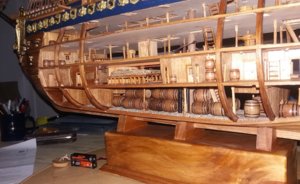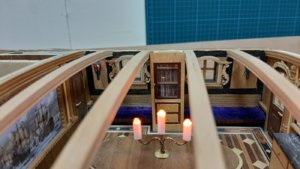- Joined
- Dec 15, 2019
- Messages
- 99
- Points
- 143

I'm posting this here as there appears to be no forum specifically for electrical things.
. . . and speaking of electrical things, the following questions will reveal my serious lack of knowledge of things electrical and electronic.
I'm considering doing a cross section and in all of the 'in my head' planning of the project I have given consideration to having lanterns inside the decks.
I understand that LED lights are the way to go -- they seem to give a good bright light with virtually no heat.
I'm thinking that LEDs rated around 3 volts would probably be suitable for inside a cross section?
I would expect to be fitting 6 - 8 LEDs in the form of hanging lanterns but Google has shown me some conflicting information as to how to wire multiple lights.
Is it feasible to have the wires for all these lights 'running around' inside the ship [in series?] but only having two wires ( a + and a - ) coming into the ship from a battery or other power source? - - - or would all lights require their wires to be led out of the ship back to battery/power source? (For 8 lights that would be 16 wires -- OOOOH! )
Some info I have read says the lights can be just wired straight from a battery via an on/off switch, while other info says a resistor needs to be fitted for each light ???
I'm confused !!!
OK ~ I'll leave the questions there for now, but there may be more in my quest to understand this stuff!
. . . and speaking of electrical things, the following questions will reveal my serious lack of knowledge of things electrical and electronic.
I'm considering doing a cross section and in all of the 'in my head' planning of the project I have given consideration to having lanterns inside the decks.
I understand that LED lights are the way to go -- they seem to give a good bright light with virtually no heat.
I'm thinking that LEDs rated around 3 volts would probably be suitable for inside a cross section?
I would expect to be fitting 6 - 8 LEDs in the form of hanging lanterns but Google has shown me some conflicting information as to how to wire multiple lights.
Is it feasible to have the wires for all these lights 'running around' inside the ship [in series?] but only having two wires ( a + and a - ) coming into the ship from a battery or other power source? - - - or would all lights require their wires to be led out of the ship back to battery/power source? (For 8 lights that would be 16 wires -- OOOOH! )
Some info I have read says the lights can be just wired straight from a battery via an on/off switch, while other info says a resistor needs to be fitted for each light ???
I'm confused !!!
OK ~ I'll leave the questions there for now, but there may be more in my quest to understand this stuff!



